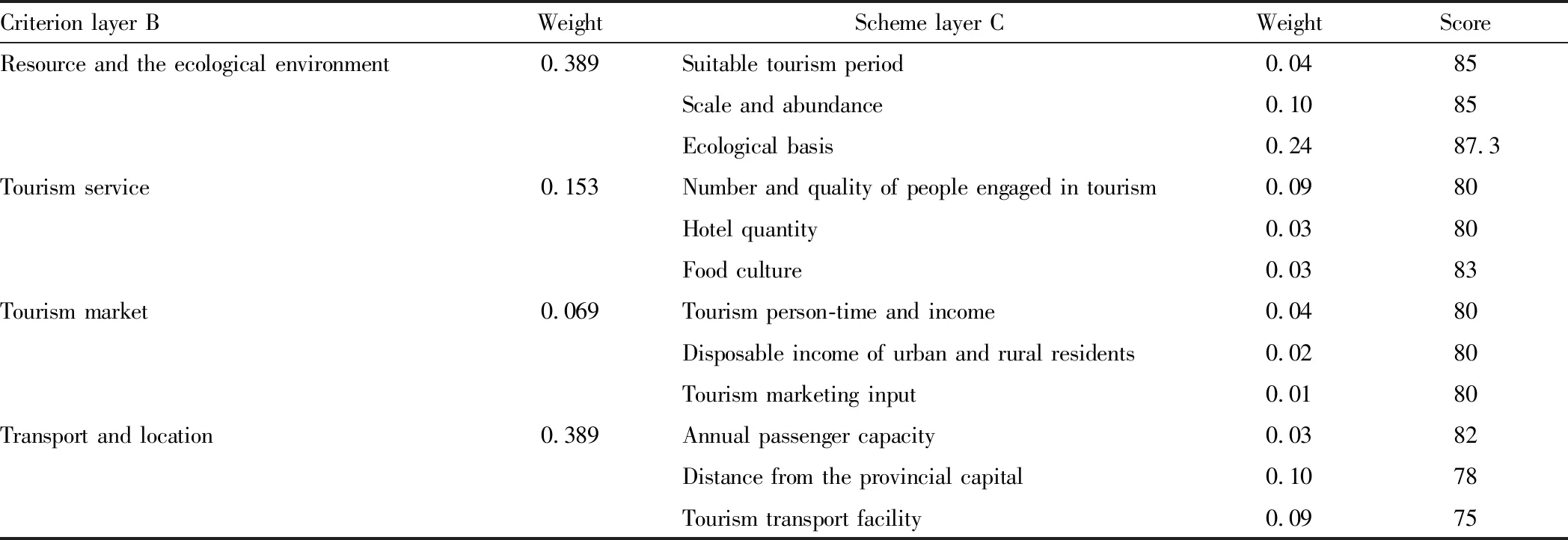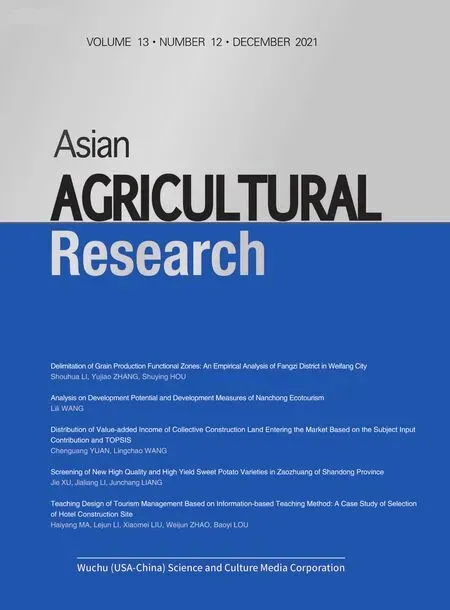Analysis on Development Potential and Development Measures of Nanchong Ecotourism
2021-02-18LiliWANG
Lili WANG
School of Geographical Sciences, China West Normal University, Nanchong 637002, China
Abstract Ecotourism is a new type of tourism characterized by unique ecological environment as the main landscape and a new trend of sustainable development of tourism industry. Nanchong region is one of the potential areas for developing ecotourism in Sichuan Province, and its potential for ecotourism is evaluated as the basis of realizing the sustainable development of industries in Nanchong region. The AHP is used to evaluate and then study the Nanchong region as per the evaluation result, so as to propose the measures and suggestion of developing ecotourism in Nanchong region.
Key words Ecotourism, Nanchong region, Potential, Measures
1 Introduction
Since the 1990s, the ecotourism in China has rapidly developed and become an important part of the tourism development with distinctive characteristics in China. The complexity of the development of ecotourism requires people to understand various factors that affect the development. Building ecological civilization is a major program that concerns the well-being of the people and the future of the nation. China has explicitly put ecological and environmental protection in a more prominent position. The evaluation of tourism resources is a process of combining qualitative and quantitative analysis. In this paper, the ecotourism resources in Nanchong City are evaluated in the light of the relevant theories of ecotourism to provide a reference for the future development of tourism.
2 Overview of research area
Nanchong City is located in the northeast of Sichuan Basin, and Nanchong region has a humid subtropical monsoon climate. The terrain is dominated by hills, of which the deep hills are in the north and shallow hills are in the south. Main rivers include Jialing River, Xichong River and Hongxi River, which belong to the Jialing River Basin. Nanchong region is rich in ecotourism resources and has obvious advantages.
3 Research methods and processes
Analytic Hierarchy Processis a method used to systematically and hierarchically analyze problems combined with qualitative and quantitative analysis. It is an effective way to convert semi-qualitative and semi-quantitative problems into quantitative problems to make people’s thinking process hierarchical and provide a more convincing quantitative basis for analysis and decision-making by comparing the related factors layer by layer and checking whether the comparison results are reasonable. According to the characteristics and development practice of ecotourism resources in the case, the evaluation index system of Nanchong ecotourism is constructed in the research based on the principles of comparability, measurability, availability and feasibility (Table 2). The system consists of the target layer, guideline layer and program layer. The target layer is the potential of ecotourism. The guideline layer includes four levels of tourism resources, ecological environment, tourism service, tourism market, location and tourism transportation. The program level consists of 12 evaluation factors.
3.1 Construction of the judgment matrix
Five attributes tend to be used by people to distinguish the capacity of things qualitatively, namely the same importance, slight importance, relative importance, strong importance and absolute importance and the value between two neighboring attributes can be selected so as to obtain nine values, namely nine scales when high precision is needed. 1-9 ratio scale method is introduced to quantify the comparison judgment easily and it is specified that judgment according to experience is indicated respectively by 1, 3, 5, 7 and 9. Elementi
is compared to elementj
: the same importance, slight importance, relative importance, strong importance and absolute importance, while the compromise value between the above two judgment grades is indicated by 2, 4, 6 and 8.CR
=CI/RI
(1)
CI
=(λ
-n
)/(n
-1)(2)

(3)

Table 1 Main tourism resources in Nanchong region

Table 2 Evaluation system of Nanchong ecotourism resources

Table 3 Matrix 1—the scale value of the criterion layer to the objective layer

Table 4 Matrix 2—the scale value of the scheme layer to the resource and the ecological environment

Table 5 Matrix 3—the scale value of the scheme layer to tourism service

Table 6 Matrix 4—the scale value of the scheme layer to the tourism market

Table 7 Matrix 5—the scale value of the scheme layer to transport and location
TheRI
value of average random consistency index is as follows:RI
=0 (n
=1);RI
=0n
=2);RI
=0.
58 (n
=3);RI
=0.
90 (n
=4);RI
=0.
12 (n
=5);RI
=1.
24 (n
=6);RI
=1.
32 (n
=7);RI
=1.
41 (n
=8);RI
=1.
45 (n
=9).
It can be determined through weight calculation of all matrixes and the consistency check can also be conducted.
Judgment matrix-1W
=(0.
389 0.
153 0.
069 0.
389)
There he stood thinking and wondering what he could do, when all of a sudden he saw three fishes swimming along, and recognised them as the very same whose lives he had saved
CI
=(λ
-n
)/
(n
-1)=(4.
044-4)/
(4-1)=0.
015
W
=(0.106 0.260 0.633),λ
=3.039,CR
=0.033<0.1Judgment matrix-3W
=(0.6 0.2 0.2),λ
=3,CR
=0Judgment matrix-4W
=(0.639 0.274 0.087),λ
=3.054,CR
=0.047<0.1Judgment matrix-5W
=(0.087 0.274 0.639),λ
=3.054,CR
=0.047<0.13.3 Layered overall ordering and the weight determination of the evaluation factors
The weight value of the indexes of the scheme layer to the ecotourism quality (objective layer A) can be calculated with the result of the layered single ordering.The experts are invited to mark the real situation of the evaluation factors to obtain the estimation value of all evaluation factors and the comprehensive result according to the ecotourism development potential in Nanchong area and the comprehensive result is calculated according to the mathematical model of Fishbein-Rosenberg, namely:

(4)
Score in all dimensions in the evaluation objective layers of ecotourism development potential is indicated withA
and the factor weight of a certain factor layer is indicated withP
; the specific score of a certain factor is indicated withQ
and the statistical sample is indicated withn
and the factor is indicated withi
. The evaluation score of all layers of ecotourism development potential in the Nanchong area is calculated according to the model of Fishbein-Rosenberg:B
=(85×0.04+85×0.1+87.3×0.24)=32.9B
=(80×0.09+80×0.03+83×0.03)=12.1B
=(80×0.04+80×0.02+80×0.01)=5.6B
=(82×0.01+78×0.1+75×0.09)=15.37The tourism resource of strong ornamental value is rich in Nanchong area and the ecotourism development potential is great, which is consistent with the evaluation conclusion that the tourism resourceB
is marked 32.9. The tourism transport and location score is 15.37, indicating that it becomes the key factor of the local economic development to develop the transport and tourism with the economic development; though Nanchong is in the poor location far from the provincial capital, the transport bottleneck of the ecotourism development is overcome with continual improvement of the transport facility. While the score of the tourism market is less as 5.6, indicating that there is more potential for the future tourism development. More advantages are created by the wide tourism development market for the ecotourism development and the accessibility of the ecotourism development is enhanced by relatively strong tourism transport capacity.
Table 8 The ecotourism quality to evaluate the weight of all factors
4 Measures for Nanchong to develop ecotourism
4.1 Focusing on both development and protection
The essence of the ecotourism industry development is to realize full development of the natural ecological resource elements and full environmental protection of the system. So it is analyzed from the macroscopic perspective that practically guaranteeing and realizing the long-term and stable and sustainable development of the ecological resource elements of the natural environment is the important premise to guarantee and realize the long-term stable and high-quality development of Chinese ecotourism industry.4.2 Promoting service and transport
The overall evaluation and re-visit rate of tourists on the scenic spots are directly affected by the satisfaction degree of service received by the tourists in the tourism destination because the tourism is a high-level life need. So the self-quality of the service personnel in the scenic spots should be strengthened and corresponding training should be periodically conducted and the hotel catering surrounding the scenic spots should also be regulated so as to improve the overall tourism service quality of the city.4.3 Conforming to the market demands
Firstly, the needed time in the ecotourism process should be reasonably distributed according to the tourism hour ratio in the tourism line design; secondly, the tourist psychology should be fully mastered so as to design relatively classic tourism lines, master space regulation and make the tourists feel better according to the requirements of minimum consumption and maximum satisfaction; finally, the tourism line design should also take into account selectivity so as to conform to tourism preferences of different tourists.杂志排行
Asian Agricultural Research的其它文章
- Research and Application Progress of Silk Fibroin Membranes
- Application Potential of Quinoa as Forage
- The Agriculture-Tourism Integration to Promote the Rural Revitalization: Taking Tea Industry-Agriculture-Tourism in Lishui City as an Example
- Delimitation of Grain Production Functional Zones: An Empirical Analysis of Fangzi District in Weifang City
- Research on the Curriculum Construction by Promoting Teaching Using Competition Based on Bloom’s Taxonomy of Educational Objectives
- Effects of Fermented Nano Chinese Herbal Medicines Replacing Antibiotics on Production Performance and Carcass Quality of Growing-Finishing Pigs
